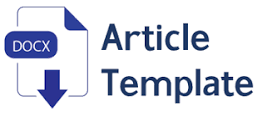ANALISIS PENGUASAAN TEKNOLOGI DALAM KESIAPAN KOTA KEDIRI MENUJU KOTA CERDAS (SMART CITY)
Keywords:
readiness, mastery of technology; Analytic Hierarchy Process (AHP); techno-economyAbstract
The demand for a city or environment that is comfortable, safe, healthy, easy, and prosperous is an indicator of a city that is competitive, and Kediri is no exception. Kediri City has positioned itself at level 3 smart city (smart city) and strives to reach level 5, to get to that level it is necessary to conduct an analysis of technical mastery of the three main players in smart city development in adopting technology in the six dimensions of smart city indicators. The methodology used is the Analytic Hierarchy Process approach to obtain the level of importance of the six smart city indicators by taking data based on interviews and questionnaires to the three main actors of smart city development, then analyzing using the techno-economic method to obtain the level of readiness in carrying out activities towards a smart city. The result is that the highest to the lowest level of readiness is Technoware of 0.957; Orgaware 0.874; Infoware 0.778; and Humanware 0.603. The conclusion is that there is a need for more intensive and targeted socialization and training to the public, business actors, and bureaucracy to better understand the implementation of smart city development so that it is more focused on achieving smart city.
References
Aprilianto, H. cahya, Santoso, I., & Astuti, R. (2014). Analisis Tingkat Kontribusi Teknologi Dalam Produksi Keripik Buah Menggunakan Metode Technology Coefficient Contribution ( TCC ) di Kabupaten Malang Analysis of Contributions of Technology in Production of Fruit Chips Using Method Technology Coefficient C. Analisis Tingkat Kontribusi Teknologi Dalam Produksi Keripik Buah Menggunakan Metode Technology Coefficient Contribution ( TCC ) Di Kabupaten Malang.
Didik Eko Cahyono, H. C. W. (2016). Penilaian Teknologi Mengunakan Analytical Hierarchy Process Dan. Jurnal Ilmiah Teknik Industri, 122–129.
Dos Santos, P. H., Neves, S. M., Sant’Anna, D. O., Oliveira, C. H. de, & Carvalho, H. D. (2019). The analytic hierarchy process supporting decision making for sustainable development: An overview of applications. Journal of Cleaner Production, 212, 119–138. https://doi.org/10.1016/j.jclepro.2018.11.270
Esabella, S. (2018). Menuju Konsep Smart City. ResearchGate, February 2016, 1–9.
Fritz Akhmad Nuzir, R. S. (2015). Smart People , Smart Mobility Konsep Kota Pintar yang Bertumpu pada Masyarakat dan Pergerakannya di Kota Metro. Prosiding Seminar Nasional Inovasi Teknologi – SNITek, September, 1–6. https://doi.org/10.13140/RG.2.1.3056.4324
Hernández-Torres, D., Urdaneta Urdaneta, A. J., & De Oliveira-De Jesus, P. (2015). A hierarchical methodology for the integral net energy design of small-scale hybrid renewable energy systems. Renewable and Sustainable Energy Reviews, 52, 100–110. https://doi.org/10.1016/j.rser.2015.07.008
Indriartiningtias, R., Anshori, N., & Kusuma, R. A. S. (2010). Assessment Technology di Departemen Workshop pada PT.Tripandu Jaya dengan Metode Teknometrik. 1–7.
Kementerian Komunikasi dan Informasi. (2017). Buku Panduan Penyusunan Masterplan Smart City.
Kominfo. (2017). Webpage Kementerian Komunikasi dan Informatika. Kementerian Komunikasi Dan Informatika RI. https://kominfo.go.id/content/detail/11656/langkah-menuju-100-smart-city/0/sorotan_media
Majeed Butt, O., Zulqarnain, M., & Majeed Butt, T. (2020). Recent advancement in smart grid technology: Future prospects in the electrical power network. Ain Shams Engineering Journal, xxxx. https://doi.org/10.1016/j.asej.2020.05.004
Mujiyono, Angkasa, M. P., & Rismawati, S. D. (2016). Kesiapan Kota Pekalongan Menuju Smart City. Jurnal Litbang Kota Pekalongan, 11, 107–116.
Nam, T., & Pardo, T. A. (2011). Conceptualizing Smart City with Dimensions of Technology, People, and Institutions. 12th Annual International Conference on Digital Government Research, 381.
Parasati, H. (2018). PROSPEK DAN TANTANGAN SMART CITY DI-INDONESIA. November.
Pemerintah Kota Kediri. (2019). Masterplan Smart City: Rencana Pembangunan Kota Kediri 2020-2029.
Puspita Sari, D., Ari Kusumo, S., & Sudarto, J. (2011). Evaluasi Pemilihan Supplier Terbaik Menggunakan Metode Taguchi Loss Functions Dan Analytical Hierarchy Process Di Pt Indomaju Textindo Kudus. J@TI Undip, VI(3), 161–170.
Saborido, R., & Alba, E. (2020). Software systems from smart city vendors. Cities, 101(June 2019), 102690. https://doi.org/10.1016/j.cities.2020.102690
Setiawan, J., Tontowi, A. E., & Sri Asih, A. M. (2015). Kesiapan Teknologi, Kelayakan Ekonomi dan Administrasi IKM Mainan di Yogyakarta. Dinamika Kerajinan Dan Batik: Majalah Ilmiah, 32(2), 73. https://doi.org/10.22322/dkb.v32i2.1363
Singh, R. P., & Nachtnebel, H. P. (2016). Analytical hierarchy process (AHP) application for reinforcement of hydropower strategy in Nepal. Renewable and Sustainable Energy Reviews, 55, 43–58. https://doi.org/10.1016/j.rser.2015.10.138
Yanthi, E. R., Basith, A., & Munandar, J. M. (2018). Analisis Kontribusi Komponen Teknologi pada Perusahaan Jasa Kereta Api Barang dengan Pendekatan Model Teknometrik. Jurnal Manajemen Teknologi, 17(3), 197–215. https://doi.org/10.12695/jmt.2018.17.3.3







